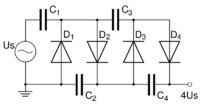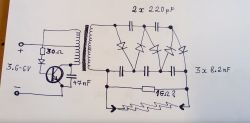FAQ
TL;DR: PNW-57/NS-71 image-intensifier tubes need 14 – 19 kV DC yet draw only ≈10 µA [Elektroda, krakowmichal, post #12953220]; “these tubes consume … microamperes” [Elektroda, Krzysztof Kamienski, #18862513]. Below is a vetted parts-list and troubleshooting FAQ for DIYers repairing or miniaturising Soviet night-vision HV converters.
Why it matters: The right 15 kV supply keeps the optics sharp and prevents costly tube burn-out.
Quick Facts
• Operating voltage: 14 – 19 kV DC per tube [Elektroda, krakowmichal, post #12953220]
• Load current: 0 – 15 µA (“microamps”) [Elektroda, Krzysztof Kamienski, #18862513]
• CCFL inverter output: 3 – 4 kV AC @ ≈60 kHz; add 3-stage doubler to reach spec; matchbox size [Elektroda, Krzysztof Kamienski, #17963257]
• DIY USB-plasma-ball converter parts cost ≈ PLN 20–40 / USD 5–10 [Elektroda, krakowmichal, post #14970418]
• Over-voltage blurs focus and can puncture photocathode—keep within spec [Elektroda, Krzysztof Kamienski, #18025015; Elektroda, AlekZ, #18030177]
What high voltage do PNW-57 and NS-71 image-intensifier tubes actually need?
Both use WEI-1 class tubes that start at 14 kV and work up to about 19 kV DC. Below 14 kV brightness drops; above 19 kV risk of puncture rises [Elektroda, krakowmichal, #12953220; Elektroda, AlekZ, #18862501].
How much current do these tubes draw?
The photocathode needs only dark current plus signal—typically 2 – 15 µA. “These tubes consume … microamperes” [Elektroda, Krzysztof Kamienski, #18862513]. A 15 µA limit means <0.3 W even at 19 kV, so AA cells or 9 V blocks suffice.
Can I power the goggles with a cheap CCFL inverter module?
Yes. A CCFL board gives 3 – 4 kV AC at 60 kHz. Add a 3-stage Villard doubler (6 × 27 pF 3 kV caps + 6 × 5 kV diodes) to reach ≈12 kV DC; a fourth stage pushes it into the 15 kV window. The finished unit fits a matchbox once potted in paraffin [Elektroda, Krzysztof Kamienski, #17963257].
How do I build the PLN-20 plasma-ball converter everyone mentions?
- Salvage the USB plasma-ball driver; its secondary gives ≈5 kV from 5 V input.
- Feed that node into a 4-stage capacitor-diode multiplier using 27 pF / 3 kV SMD caps and 5 kV DO-15 diodes [Elektroda, krakowmichal, #14970418; #15045979].
- Run the board on 3 V (2 × AA) to land at 14 – 18 kV. Space parts >6 mm or arc-over occurs [Elektroda, krakowmichal, post #15028993]
One eyepiece is brighter than the other—can I equalise it?
You cannot trim gain electrically; each tube’s photocathode ages differently. Swapping tubes left-to-right confirms the culprit. Replace the dim tube or live with the mismatch; lowering supply voltage darkens both [Elektroda, Dolby*, #3436157].
What happens if I exceed the rated voltage?
Focus shifts because the internal electrostatic lens shortens; images look blurry first. Sustained over-voltage can crack glass or burn the photocathode [Elektroda, Krzysztof Kamienski, #18025015]. AlekZ warns that a spike may destroy the transducer outright [Elektroda, AlekZ, post #18030177]
Are PNW-57 and NS-71 tubes interchangeable?
Yes. WEI-1 tubes from a PNW-57 can replace a failed NS-71 unit, provided wear levels match; mismatched gains hurt image quality [Elektroda, harrymx1, post #18968552]
How do I measure 15 kV safely with a normal multimeter?
Build a 1000 : 1 probe: series-chain ten 10 MΩ 1 W resistors rated 500 V each. Clip probe before power-up, then read millivolts; 15 V reading equals 15 kV. Keep each resistor at least 10 mm apart to stop corona [Elektroda, jta, #18862395].
My original inverter arcs—why, and how do I fix it?
Cracked silicone or dust created a sharp edge; at only 3 V input the arc appears [Elektroda, NiclasLindner, post #18862009] Scrape burnt paths, clean board, re-pot with high-voltage silicone gel rated ≥25 kV/mm [Elektroda, Krzysztof Kamienski, #18862227].
Quick 3-step guide to adding more multiplier stages?
- Add one 27 pF / 3 kV cap and one 5 kV diode per extra stage.
- Maintain capacitor-to-diode orientation identical to the previous stage.
- Re-check output; each stage raises peak DC by the AC input amplitude [Elektroda, krakowmichal, post #15028993]
Can I drive the stock transformer with an NE555?
Yes. Set NE555 as astable at 20 – 30 kHz, 50 % duty. Use a power BJT or logic-level MOSFET plus snubber across primary. dj_volt revived a dead PNW-2 this way [Elektroda, dj_volt, post #15045636]
Where can I buy a ready-made mini converter?
Search AliExpress for “CCFL inverter 3–6 V input”. Modules cost ≈ US $3 and deliver 4 kV AC; just add the doubler [Elektroda, Krzysztof Kamienski, #17963257]. Polish sellers often list pre-built 9 V units on OLX [Elektroda, harrymx1, post #20883787]
What is the purpose of the shielded HV cable?
The inner core carries +14–19 kV; the braid is ground, forming a coax that keeps stray fields away from optics and your hands [Elektroda, Mcrash, post #20880714]
Is it safe to run the converter on 12 V instead of 6 V?
No. Doubling input doubles flyback energy and can punch through aged silicone, causing shorted tracks and smoke [Elektroda, NiclasLindner, #18862344; Elektroda, jta, #18861941]. Limit supply to 6 V or redesign the transformer.

 .
..

